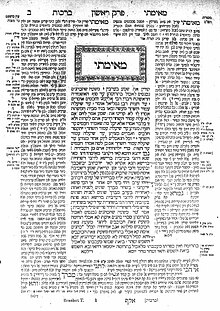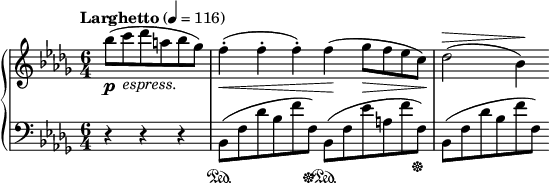Incipit
This article includes a list of generalreferences,butit lacks sufficient correspondinginline citations.(January 2017) |

Theincipit(/ˈɪnsɪpɪt/IN-sip-it)[a]of a text is the first few words of the text, employed as an identifying label. In amusical composition,an incipit is an initial sequence ofnotes,having the same purpose. The wordincipitcomes fromLatinand means "it begins". Its counterpart taken from the ending of the text is theexplicit.[3]
Before the development oftitles,texts were often referred to by their incipits, as with for exampleAgnus Dei.During themedieval periodin Europe, incipits were often written in a differentscriptor colour from the rest of the work of which they were a part, and "incipit pages" might be heavily decorated withillumination.Though the wordincipitis Latin, the practice of the incipit predatesclassical antiquityby several millennia and can be found in various parts of the world. Although not always called by the name ofincipittoday, the practice of referring to texts by their initial words remains commonplace.
Historical examples[edit]
Sumerian[edit]
In theclay tabletarchivesofSumer,catalogs of documents were kept by making special catalog tablets containing the incipits of a given collection of tablets.
The catalog was meant to be used by the very limited number of officialscribeswho had access to the archives, and the width of a clay tablet and its resolution did not permit long entries. An example from Lerner (1998):[4]
Honored and noble warrior
Where are the sheep
Where are the wild oxen
And with you I did not
In our city
In former days
Hebrew[edit]

Many books in theHebrew Bibleare named inHebrewusing incipits. For instance, the first book (Genesis) is calledBereshit( "In the beginning..." ) andLamentations,which begins "How lonely sits the city...", is calledEykha( "How" ). A readily recognized one is the "Shema" orShema Yisraelin theTorah:"Hear O Israel..." – the first words of the proclamation encapsulating Judaism's monotheism (see beginningDeuteronomy6:4 and elsewhere).
All the names ofParashotare incipits, the title coming from a word, occasionally two words, in its first two verses. The first in each book is, of course, called by the same name as the book as a whole.
Some of thePsalmsare known by their incipits, most noticeablyPsalm 51(Septuagint numbering: Psalm 50), which is known inWestern Christianityby its Latin incipitMiserere( "Have mercy" ).
In theTalmud,the chapters of theGemaraare titled in print and known by their first words, e.g. the first chapter ofMesekhetBerachot( "Benedictions" ) is called Me-ematai ( "From when" ). This word is printed at the head of every subsequent page within that chapter of the tractate.
Inrabbinicusage, the incipit is known as the "dibur ha-matḥil" (דיבור המתחיל), or "beginning phrase", and refers to a section heading in a published monograph or commentary that typically, but not always, quotes or paraphrases a classic biblical or rabbinic passage to be commented upon or discussed.
Many religious songs and prayers are known by their opening words.
Sometimes an entire monograph is known by its "dibur hamatḥil". The published mystical andexegeticaldiscourses of theChabad-Lubavitchrebbes (called "ma'amarim" ), derive their titles almost exclusively from the "dibur ha-matḥil" of the individual work's first chapter.
Ancient Greek[edit]
The final book of theNew Testament,theBook of Revelation,is often known as the Apocalypse after the first word of the original Greek text,ἀποκάλυψιςapokalypsis"revelation", to the point where that word has become synonymous with what the book describes, i.e. theEnd of Days(ἔσχατονeschaton"[the] last" in the original).
Medieval Europe[edit]

Incipits are generally, but not always, in red in medieval manuscripts. They may come before a miniature or anilluminatedorhistoriated letter.
Papal bulls[edit]
Traditionally,papal bullsandencyclicals,documents issued under the authority of thePope,are referenced by theirLatinincipit.
Hindu texts[edit]
Some of themantras,suktasfrom the hymns of theVedas,conform to this usage.
Modern uses of incipits[edit]
The idea of choosing a few words or a phrase or two, which would be placed on the spine of a book and its cover, developed slowly with the birth ofprinting,and the idea of a title page with a short title and subtitle came centuries later, replacing earlier, more verbose titles.
The modern use of standardized titles, combined with theInternational Standard Bibliographic Description(ISBD), have made the incipit obsolete as a tool for organizing information in libraries.
However, incipits are still used to refer to untitled poems, songs, and prayers, such asGregorian chants,operaticarias, many prayers and hymns, and numerous poems, including those ofEmily Dickinson.That such a use is an incipit and not a title is most obvious when the line breaks off in the middle of a grammatical unit (e.g.,Shakespeare'ssonnet55 "Not marble, nor the gilded monuments" ).
Latinlegal concepts are often designated by the first few words, for example,habeas corpusforhabeas corpus ad subjiciendum( "may you have the person to be subjected [to examination]" ) which are itself the key words of a much longer writ.
Manyword processorspropose the first few words of a document as a default file name, assuming that the incipit may correspond to the intended title of the document.
The space-filling, or place-holding, textlorem ipsumis known as such from its incipit.
Occasionally, incipits have been used for humorous effect, such as in theAlan Plater-written television seriesThe Beiderbecke Affairand its sequels, in which each episode is named for the first words spoken in the episode (leading to episode titles such as "What I don't understand is this..." and "Um...I know what you're thinking" ).
In music[edit]
 |
| Incipit for Chopin'sNocturne in B-flat minor, Op. 9, No. 1,single-staff version |
 |
| Incipit for Chopin'sNocturne in B-flat minor, Op. 9, No. 1,full-score version |
Musical incipits are printed in standard music notation. They typically feature the first fewbarsof a piece, often with the most prominent musical material written on a singlestaff(the examples given at right show both the single-staff and full-score incipit variants). Incipits are especially useful in music because they can call to mind the reader's own musical memory of the work where a printed title would fail to do so. Musical incipits appear both in catalogs of music and in the tables of contents of volumes that include multiple works.
In choral music, sacred or secular pieces from before the 20th century were often titled with the incipit text. For instance, the proper of theCatholicMassand theLatintranscriptions of the biblical psalms used as prayers during services are always titled with the first word or words of the text.Protestanthymns of the eighteenth and nineteenth centuries are also traditionally titled with an incipit.
In computer science[edit]
In computer science, longstrings of charactersmay be referred to by their incipits, particularlyencryption keysorproduct keys.Notable examples includeFCKGW(used byWindows XP) and09 F9(used byAdvanced Access Content System).
See also[edit]
Notes[edit]
- ^Recommended by theOxford English Dictionary,[1]but competes in everyday usage with several others:/ɪnˈsɪpɪt/in-SIP-it,/ˈɪnkɪpɪt/IN-kip-it,/ɪnˈkɪpɪt/in-KIP-it,/ˈɪntʃɪpɪt/IN-chip-itand/ɪnˈtʃɪpɪt/in-CHIP-it.Of these, the use of second-syllable stress and of/k/for letter⟨c⟩is endorsed byMerriam-Websteron its dictionary web site.[2]Pronunciations with/tʃ/are based on theItalianrendition of letter⟨c⟩before⟨i⟩.For discussion of the variants, seeChoralNetArchived2018-03-31 at theWayback Machine.
References[edit]
- ^"incipit".Oxford English Dictionary(Online ed.).Oxford University Press.(Subscription orparticipating institution membershiprequired.)
- ^"incipit".Merriam-Webster.Retrieved12 May2020.
- ^"Incipit and Explicit - Incunabula - Dawn of Western Printing".ndl.go.jp.
- ^Lerner, Frederick Andrew.The Story of Libraries: From the Invention of Writing to the Computer Age.New York: Continuum, 1998.ISBN0-8264-1114-2.ISBN0-8264-1325-0.
Other sources
- Barreau, Deborah K.; Nardi, Bonnie. "Finding and Reminding: File Organization From the desktop".SigChi Bulletin.July 1995. Vol. 27. No. 3. pp. 39–43
- Casson, Lionel.Libraries in the Ancient World.New Haven, Connecticut: Yale University Press, 2001.ISBN0-300-08809-4.ISBN0-300-09721-2.
- Malone, Thomas W. "How do people organize their desks? Implications for the design of Office Information Systems".ACM Transactions on Office Information Systems.Vol. 1. No. 1 January 1983. pp. 99–112.
- Nardi, Bonnie; Barreau, Deborah K. "Finding and Reminding Revisited: Appropriate metaphors for File Organization at the Desktop".SigChi Bulletin.January 1997. Vol. 29. No. 1.
